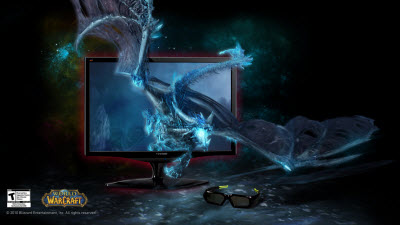 Monitor maker ViewSonic and graphics company Nvidia are teaming up to provide a new generation of 3D monitors targeted at game and movie fans that will ship in August.
Monitor maker ViewSonic and graphics company Nvidia are teaming up to provide a new generation of 3D monitors targeted at game and movie fans that will ship in August.
ViewSonic is unveiling its 24-inch V3D245 LED monitor today, which works with Nvidia’s 3D Vision wireless glasses. The monitor is priced competitively in part because it integrates the 3D Vision emitter that is otherwise sold separately.
The big question for 3D remains whether anyone really cares about it. Last week, Electronic Arts chief executive John Riccitiello said at the company’s annual meeting that there wasn’t much consumer uptake for 3D gaming. While 3D looks great in theaters, consumers don’t necessarily want to spend a lot of money on it at home.
But there is some support for 3D gaming. Nielsen statistics from September 2010 show that 71% of gamers want to play their games in 3D. In April 2010, the Consumer Electronics Association released findings of a study about the interest of 3D gaming and found that one in four people are interested in a home 3D video game experience.
Walnut, Calif.-based ViewSonic recognizes some of the cost concerns and that’s why it is selling the monitor for $499. That’s steep compared to $250 typical monitors, but it’s a lot cheaper than past versions. This new monitor can display images in 1080p, or full high-definition resolution for a sharper 3D image.
“We can hit a much better price point now,” said Erik Willey, LCD monitor and PC product marketing manager at ViewSonic, in an interview. “As the technology matures, the cost is coming down.”
“We want to make it as easy as possible to adopt 3D,” added Nvidia marketing manager Michael McSorley.
The monitor uses power-saving LED (light-emitting diode) technology and can refresh images at 120 times per second. That’s about twice as fast as most games run. With the emitter, the monitor can flash one image to one eye and then another image to the other eye, producing a slightly shifted point of view that makes the image seem like it is three-dimensional. The 1920 x 1080 resolution screen has a contrast ratio of 20 million to 1 and it comes with a high-definition multimedia interface (HDMI) 1.4 cable so that it can be connected to a PlayStation 3 game console as well as a gaming PC. It can also be connected to a Blu-ray 3D movie player.
Nvidia says 550 games are now compatible with its 3D Vision technology. YouTube also has a 3D movie section that supports 3D vision.
The companies are working on an ecosystem that could eventually be very appealing to consumers, particularly as prices for the 3D technology come down further. At some point, the 3D imagery will come along for free with most TVs, monitors and other gear.
Willey said that the industry is slowly but surely eliminating any customer objections to 3D. But as Riccitiello at EA pointed out, customers aren’t going crazy about this technology yet.
ViewSonic was founded in 1987 and is one of the major makers of displays.


